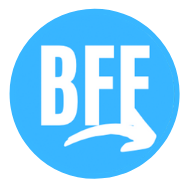If you've just discovered Mewing you may be feeling a wide array of emotions. Excited, worried, curious - maybe even downright confused.
Believe me, I understand. When I first discovered all of this it was like a new world opened up...
It's exciting, but also confusing.
My goal with this article is to make it as simple. I want you to be able to do mewing properly and start seeing results, without all the confusion and angst around it.
Ready? Alright then, let's get started!
What is this Mewing thing, anyways?
When people first hear about Mewing they may assume it's about a cat or a Pokemon? What is Mewing?
It can be tough to define what Mewing is (it came from the internet). But let's give it a shot:
Mewing (verb): the deliberate attempt to improve your tongue's position on your upper palate, to make you more attractive and healthier over time.
It was originally popularized by Dr. Mike Mew on his Youtube Channel Orthotropics.
The channel teaches people how their tongue posture and function affects the appearance and growth of their jaw.
The channel quickly caught momentum on some online forums, and gradually the term "Mewing" was born.
But what exactly does Mewing do, and does it affect the shape of your face?
How does Mewing affect my face shape?
There is no question that your tongue posture affects how you look. But the question is, how? And can you improve the way you look through Mewing?
Your tongue posture has already affected the development of your jaws, facial features, posture, and airway, whether you know it or not.
Let's dive into exactly how this is the case.
It affects your facial bones and jaw
When kids are growing, their faces and bodies change quickly. This is equally true for their teeth and the bones of their jaws.
One bone of particular importance, is the maxilla. The maxilla is the bone that makes up our mid-face. It sits directly above our upper palate, where our sits at rest.
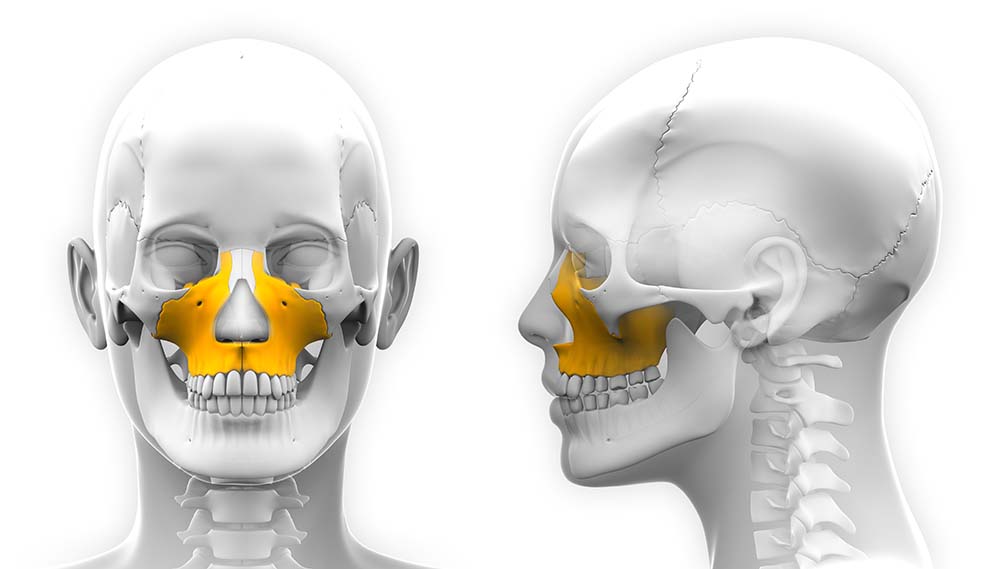
The maxilla bone is directly above the upper palate
To make a long story short - when your tongue is up on the roof of your mouth, it supports this maxilla bone. Not only that, it exerts a force on this bone - constantly.
This force on the upper palate and maxilla affects how it grows. If the tongue exerts proper force on the upper palate, it causes the maxilla to develop laterally and anteriorly (forward and wide). This maxilla and alveolar bone also house your teeth. So, naturally, if your maxilla is narrow - your dental arches are narrow. And that's what causes crooked teeth.
Studies of the bones of our ancestors show that almost none of them had crooked teeth. And almost everyone had wide maxillas and well-developed jaws.
Dr. Mike Mew says if we saw our prehistoric ancestors, we may not even recognize them because of how different they would look to us!
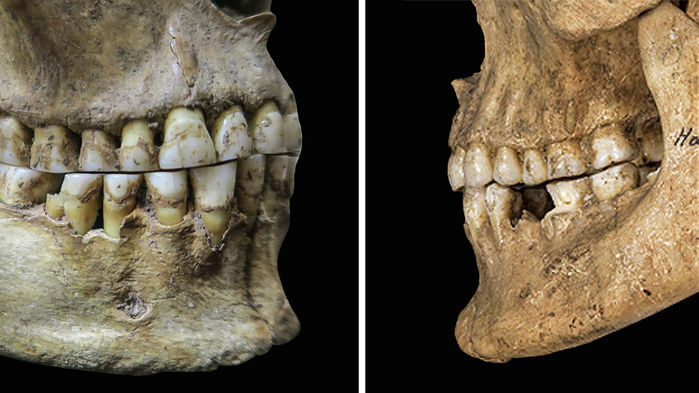
An image of our hunter-gatherer ancestors skulls & teeth (left)
So, if we had ideal tongue posture while growing up, we would have had ideal facial growth (in theory).
This essentially means that our jaws would have developed wide and forward, with room for all of our teeth. Our face shape would be more "traditionally attractive", and we would breathe better through our noses, and have better posture.
I know these are some pretty bold claims - but let's explain why this is the case.
How Mewing Affects Your Face
It's pretty easy actually to identify those who've grown up with proper tongue posture. Once you begin to identify the differences between forward growth, and less than ideal facial growth, it will be easy for you to see in friends, family, and yourself (which can become an obsession, so please be careful).
As the tongue falls down and away from the palate, several negative consequences ensue. Firstly, your palate will become more narrow, and will be "set back".
Because the tongue was not up on the palate (usually due to mouth breathing), it was not able to exert the proper force and support it needed for the ideal development of the maxilla and upper jaw.
So, as a result? The jaw will become more narrow, and smaller. This is the cause of many other negative consequences to one's appearance. We can see some of those depicted in the photo below:
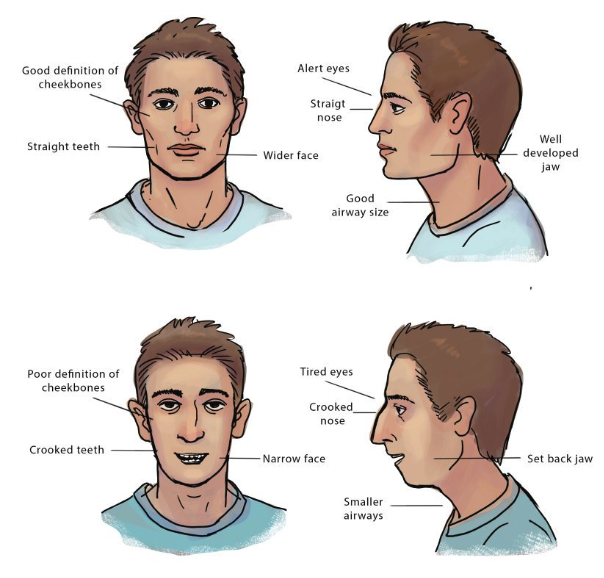
As you can see from the image above, there are many differences to note. It is not black and white, however, these are generally the distinctive features in people who don't have proper tongue posture:
"Sunken" look of Mid-face:
Long, narrow face
Sunken eyes (tired eye look)
Larger Bridge of Nose
Less Prominent Cheekbones
There are other ways that Mewing and tongue posture can affect your appearance, but for now we'll leave it at that. Because - it's not all about looks. Having proper tongue posture is extremely important for your health as well.
Mewing affects your posture
Have you noticed people's posture getting worse?
It's no surprise since the advent of technology, smartphones, and computers, that our posture has been declining rapidly. But did you know having poor tongue posture directly makes your posture worse?
Let's look at how.
The muscles on the front of your neck, that stabilize your head (keep your head upright) are related to the function of your tongue.
These are called your deep cervical flexors.
When your tongue is up on your palate, that force of your tongue acts to stabilize your neck through the activation of these cervical flexors.
This means that your tongue being on your upper palate essentially acts as an anchor to keep your head upright.
If your tongue drops, if you mouth breathe, or have poor tongue posture, it will directly affect your head. It will lead to forward head posture.

Forward head posture - the arch nemeses to Mewing
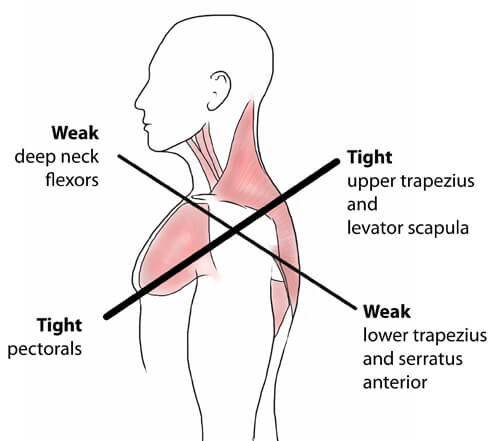
Deep cervical flexors contribute to FHP
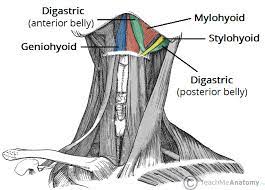
Suprahyoid muscles connected to tongue
When the tongue drops from the upper palate, these muscles relax. They get weak and stop firing properly.
This causes the head to come forward and rotate, creating the arch nemeses of Mewing: forward head posture.
When your head is forward it's harder for your tongue to push up on your palate. So it works both ways. Chicken, or an egg?
The bottom line is this: better tongue posture will improve the position of your head and the posture of your entire body.
The whole spine is connected.
It affects the way that you breathe
Perhaps the most important consequence of mouth breathing and low tongue posture, is its impact on nasal breathing.
When the jaw is underdeveloped, and the tongue is not toned and strengthened properly, it leads to an underdeveloped airway.
In other words, it makes it harder to breathe through your nose.
Unfortunately, many people are not aware of the devastating health effects that follow chronic, habitual mouth breathing.
Our nose humidifies and warms the air as it enters our lungs. It also provides greater oxygenation to our muscles and regulates the parasympathetic nerve response in our bodies.
In other words, when we mouth breathe we feel tired, fatigued, and stressed out. It leads to declining health, and many other negative symptoms.
When we breathe through our noses, we will be more relaxed, healthier, and more well-rested at night.
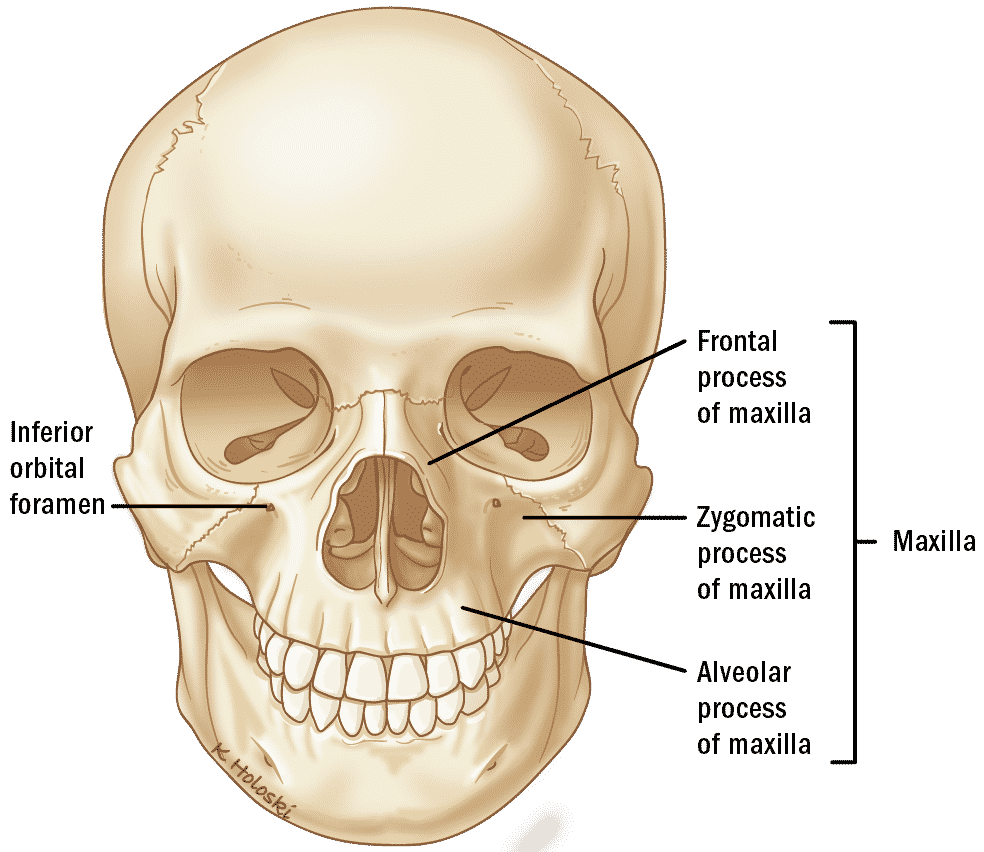
A narrow upper palate means a narrow nasal cavity
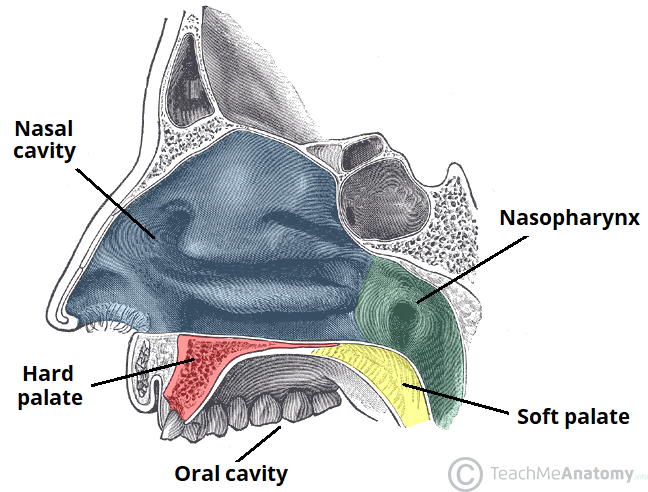
The roof of the mouth is the floor of the nose
The jaws and tongue impact your airway in 2 different ways.
1) The narrowing of your maxilla also makes your nasal airway smaller
2) The inability of your tongue to be up on your palate means it will fall back into your airway
As the maxilla narrows, so does the floor of the nose. The nasal cavity is directly superior to the maxilla. This means that a narrow palate = a narrow nasal cavity. In other words, less space to breathe through your nose.
Then there's the issue of airway obstruction. If there's less room for your tongue (or if your tongue is not strengthened properly) it will not be able to sit on your upper palate.
When it's not able to be up on your upper palate, where does it go?
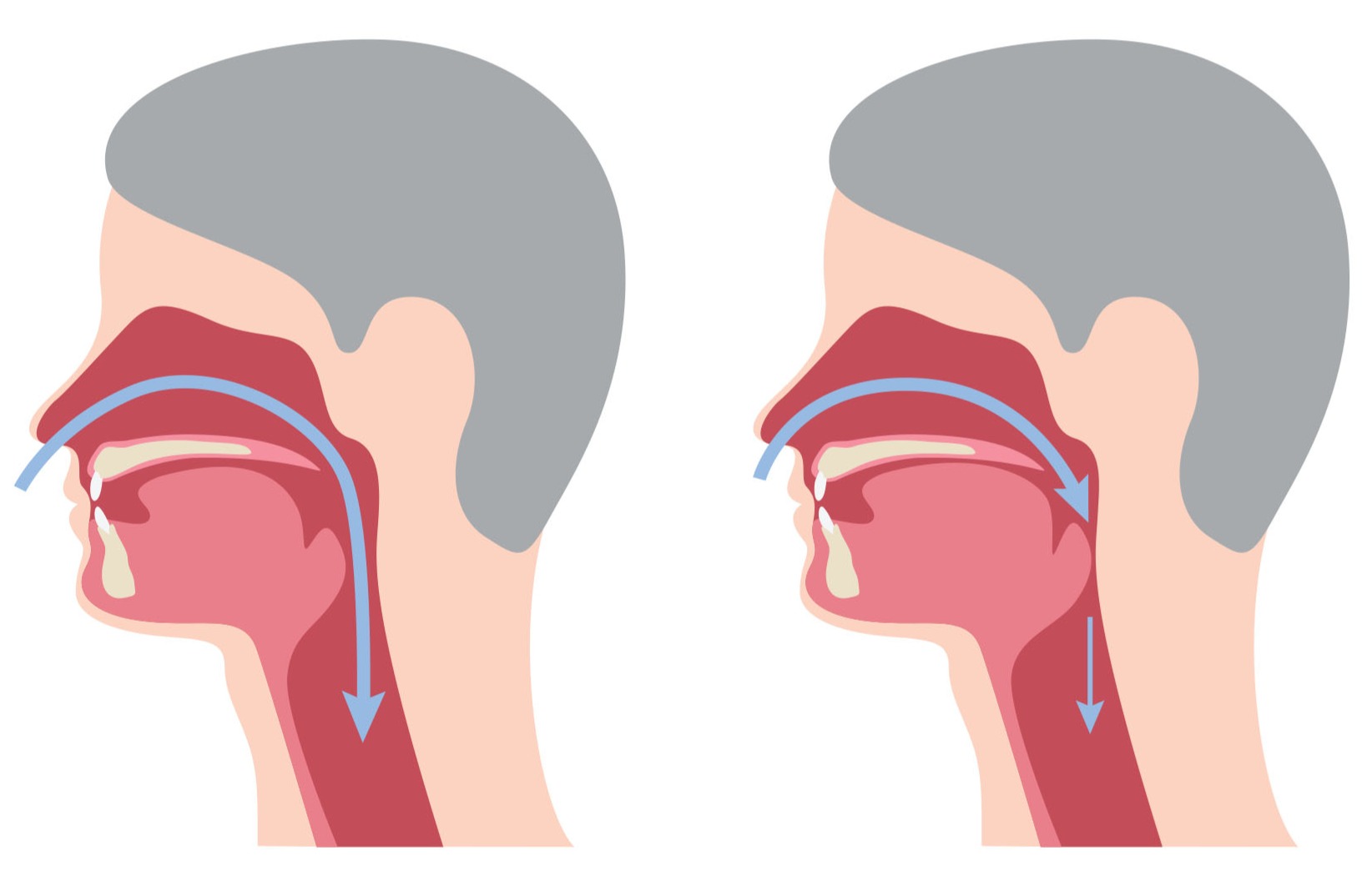
It falls down and backwards, into your airway. The size of your oropharynx is directly related to the root of your tongue. The further back your tongue is, the less room there is for your airway.
These things combined to create great difficulties for people when it comes to nasal breathing, sleep apnea, and health problems.
There is a lot of great work being done by airway dentists across the world right now. And if you are dealing with a severe breathing or health-related issue, it's best to have an assessment from a dentist specializing in airway or sleep.
How to Mew
I had just gotten off the bus in Toronto, Canada. It was a winter's day, snow covering the ground, and my face numb from the freezing cold air.
However, I was excited.
I was going to meet with a myofunctional therapist for the first time. I was 19.
At the time, I had no idea that something as simple as a small change in my tongue posture could have big changes in my life.
After that appointment, I knew.

"Lips together, teeth together, tongue on the roof of the mouth" - Dr. Mike Mew
Mewing is very simple. Actually being able to do it properly, is a different story.
Here are the simple steps to Mewing (keeping proper tongue posture):
- 1Keep your lips together (breathe through your nose, not your mouth)
- 2Keep your teeth together (lightly touching, called "butterfly bite")
- 3Keep your tongue on the roof of your mouth in a suction hold (as much of your tongue as possible up on your palate).
However, it gets more confusing than this. Because simply telling someone to "put their tongue on the roof of their mouth" is not enough for most people.
Let's look at it in more detail.
Where should my tongue be?
For starters, the tip of your tongue should be resting on your upper palate, a few millimetres behind your front teeth.
Many people have their tongue touching their teeth. This is incorrect, and many times a sign of a tongue thrust (more on this later).
For now, the tip should be resting just before the front ridges of your palate (that bumpy part), yet still just behind your front teeth.
This will guide the rest of your tongue as well, so it's an important first step.
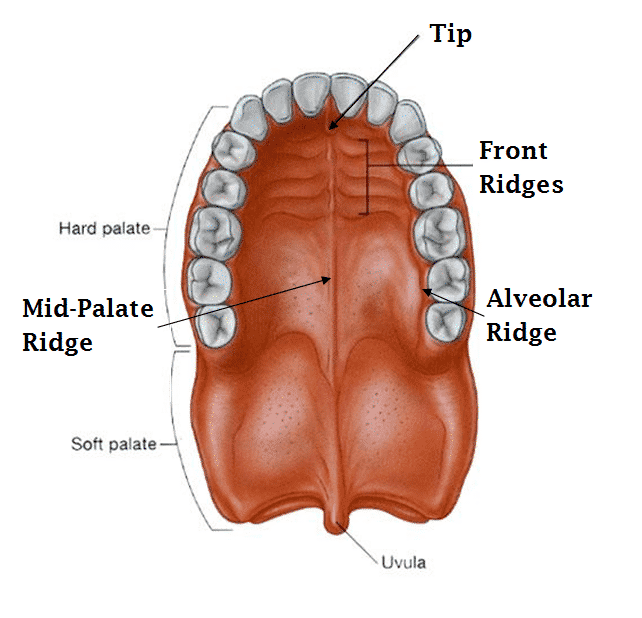
There are many exercises and techniques to get your tongue familiar with this spot, if you wish to learn those check out our free intro to tongue posture video course here.
What about the rest of my tongue?
Ideally, your entire tongue should be suctioned to the roof of your mouth - from front to back. Many people have difficulty with this (I'll explain why below).
You want your entire tongue to be up on your palate. This will give you the best chance of getting results, as your whole tongue will be exerting force onto your maxilla.
The back 1/3 of your tongue
An important part of maximizing results you can see from Mewing has to do with the root of your tongue (also called the posterior, or back 1/3 of your tongue).
If you want to have a significant impact on your facial development, the back 1/3 of your tongue is crucial.
You want to get the entire tongue exerting a force on your upper palate, including the middle and back third.
While important, this is also the most difficult aspect of Mewing for many people.
It's pretty easy for most people to get the front of their tongue up.
The back however is much more difficult. And there are a few reasons for this.
Usually, the main reason is that they don't have room. In other words, their palate is too small for their tongue to fit. So? It goes back into their airway, making it hard for them to breathe.
This is why the more someone mouth breathes, the more narrow their palate becomes. And the smaller their palate, the more difficult it is to get their tongue up.

Trying the "Ring" technique
One way to familiarize yourself with the back third of your tongue is by saying the word "RINGGGG." Emphasize the "NG" sound (you can do this with any ING word).
When you do this, you will feel the back of your tongue making contact with the roof of your mouth. If you can hold this position, you will be using more of the posterior portion of your tongue.
What is a "suction hold"?
If you went inside someone's mouth who has very good tongue posture, you would see something called a "suction hold".
This essentially means that the negative pressure created between the tongue and upper palate causes the tongue to be "suctioned" to the palate.
Many people who have good tongue posture simply maintain this suction hold with little to no effort - it is just what is normal to them.
Others, however, need to deliberately try to create this suction hold and practice it over time through exercise and repetition.
Try the suction motion by going to swallow (notice the "sweeping action of your tongue?).
Repeat this "tongue sweep" without actually swallowing the saliva. You should notice the space between your tongue and upper palate getting smaller and smaller. Keep doing this motion (without swallowing) until you create a sort of vacuum on your upper palate.
This is how you can get familiar with how your tongue creates this suction to your upper palate.
What about my lips & teeth?
Your lips should be fully sealed through most of the day. There should be no point where your lips separate (when your mouth is closed of course).
As a side note, you want to breathe through your nose as much as possible (aside from eating, talking, laughing, and any other activity that involves speech).
Your teeth should be in light contact. This is sometimes referred to as a "butterfly bite". Meaning your teeth are all make slight contact while your tongue is exerting a force opposing this bite.
When it comes to teeth - there is a lot of nuance and questions.
Many people have overbites, underbites, open-bites, cross-bites, and other forms of malocclusions.
Some of you may feel that your front teeth make contact more easily than your molars or vice versa.
These complexities are beyond what is discussed on this site - if you have an orthodontic concern, of course, it would be best to visit an Orthodontist.
However, for our purposes, the focus is on improving your tongue posture. As long as your teeth are together (and you don't have any severe pain, TMJ, breathing issues etc.) and your tongue posture is improving, it is my belief that you are on the right path.
In other words, it's believed by many professionals I've spoken to that you don't need to have a perfect bite to do Mewing or improve your tongue posture. And in some cases, myofunctional therapy and improved tongue posture can improve your bite.
This of course is not medical advice, and if you have an orthodontic concern about your bite being unstable - it's best to visit an orthodontic or holistic dentist for a complete assessment.
Swallowing Pattern
We swallow hundreds of times per day. Yet, many of us are completely unaware of the way in which we swallow.
Swallowing is one of the main functions of your tongue. And as Mike Mew often says: posture and function are closely related.
By improving your swallowing pattern, your resting tongue posture will improve. By improving your tongue's resting posture, you will also improve your swallowing pattern.
This is a beautiful virtuous cycle that we want to create! However, for many, this works the other way and becomes a vicious cycle.
And it starts with an improper swallowing pattern.
Tongue Thrust: The Incorrect Pattern
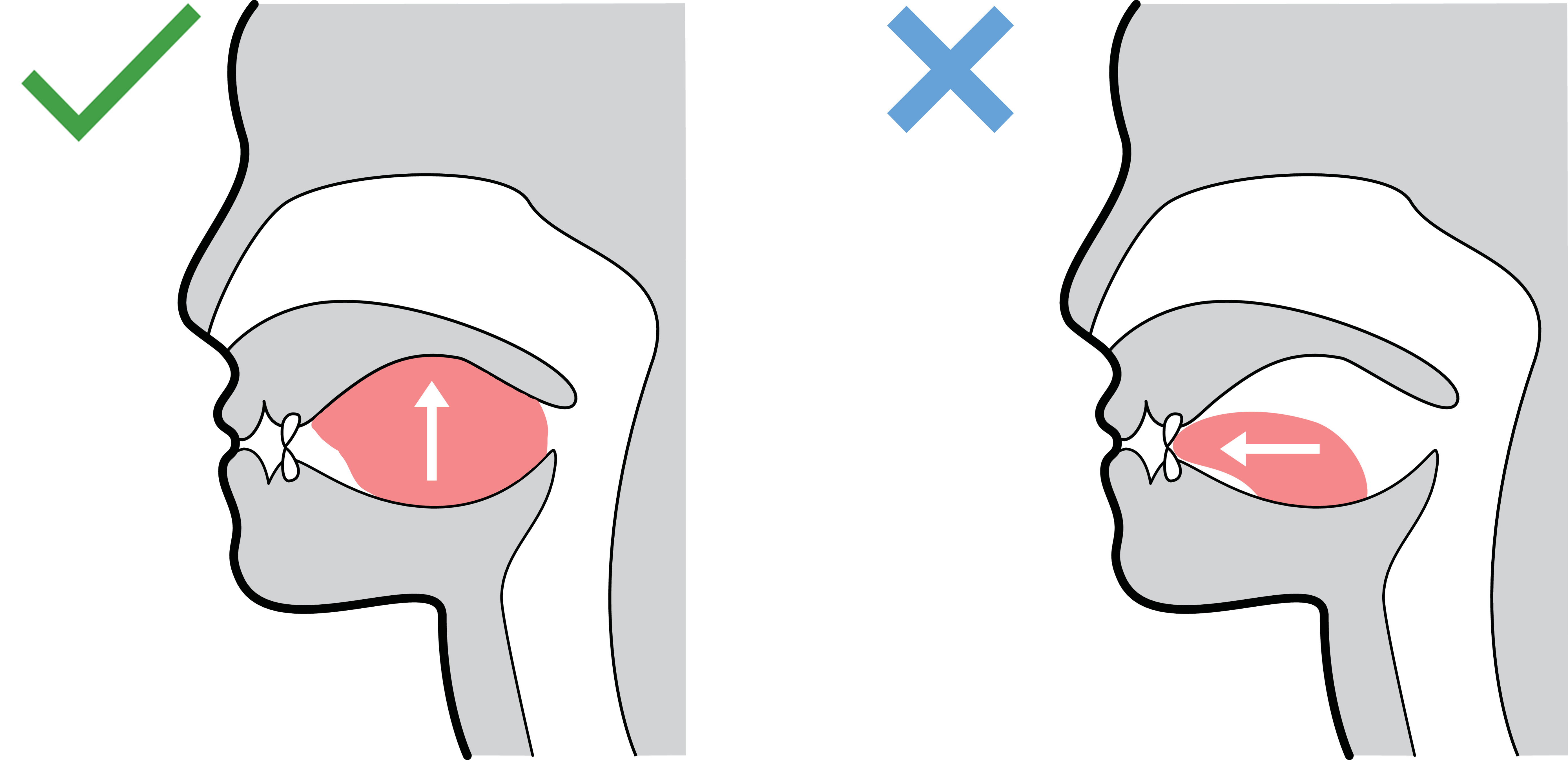
A tongue thrust is when your tongue pushes forward and touches your teeth when you swallow.
When you initiate the swallow, your tongue must push against something to create the negative force that begins the swallowing pattern.
If you swallow properly, your tongue pushes ONLY against your upper palate.
If you swallow improperly (tongue thrust), your tongue will come forward, and your lips and cheeks will work to oppose this force, and that will initiate the swallowing pattern.
What's the problem here?
If your tongue is constantly pushing against your teeth when you swallow, it's not pushing against your palate.
It is also probably not resting against your palate. And this means your maxilla is not being supported by the pressure of your tongue (as much as it could be).
How can I tell the difference?
If you want to know whether you swallow correctly or not, you can do so in two ways.
1) Pay attention to your tongue and lips when you swallow
2) Look in the mirror when you swallow
Go to swallow now, and pay attention to the action of your tongue and lips. If you feel only the tongue moving and pushing against the palate with little movement of your lips, you swallow correctly.
If you feel your lips and cheeks moving or exerting force, then you have some degree of a tongue thrust.
You can also look in the mirror when you swallow. If you notice your lips and cheeks moving, then you have some degree of tongue thrusting.
However, if while swallowing nothing above your neck moves, then you swallow correctly. Pay close attention, however, because the movement is so subtle, that you could easily be using your lips and cheeks and just unaware of it.
Dr. Mike Mew refers to this as the "Mona Lisa Swallow", essentially meaning the facial expression does not change at all the entire time
Clever right?
Final Note on Swallowing Pattern
One last thing to keep in mind is that this is not black and white. It's not like one percentage of the population has a tongue thrust, and the other has a perfect swallowing pattern. There is nuance.
Meaning, some people have a very obvious tongue thrust that would be diagnosed by a dentist. Other people may just have a slight tongue thrust where they could practice swallowing properly and it would improve over time.
Most people will fall into this grey area.
PAUSE: Where is Your Tongue Right Now?
Take a moment now to notice where your tongue is by asking the following questions:
1) Are my teeth and lips together? (no space between upper/lower lip) Y/N
2) Where is the tip of my tongue? (is it touching my teeth at all) Y/N
3) Where is the back of my tongue? (is it on my upper palate?) Y/N
4) Do I feel my tongue suctioned to my upper palate? Y/N
It is a good habit to get into to regularly ask yourself these questions. Get into the habit of noticing whether you have proper tongue posture, or not.
What is the ultimate goal of Mewing?
The way I see it, the goal of mewing is to maximize your tongue's resting posture. Improving it more and more every day.
The reality is, there are many ways to do this beyond consciously Mewing or thinking about it (which is a great place to start, by the way).
However, as many people in the Mewing community already know, there are many other ways you can improve your results.
There are myofunctional therapy exercises, improving your posture, products such as Myospots, chewing to strengthen your jaw muscles, improving your core strength in the gym - all of these things will lead to improved tongue posture.
Check out our article on how to supercharge your Mewing results for a more in-depth look at how to further improve your results.
Also, make sure you do our Intro to Tongue Posture online course. It's completely free - and we cover everything you need to know to get started on the path to improving!
FAQ and Problems People Face with Mewing
The reality is, it's easy to explain what perfect tongue posture is. But actually achieving that posture is a completely different story.
Many people have limiting factors that prevent them from Mewing correctly. Some of these are easy to fix. Others, unfortunately, are not.
To save you some trouble and time, I've included a list below of the most common questions and problems that people have with Mewing.
If you have a question that is not on this list - comment on the post below and we will add it to this article over time!
Problem #1: I can't breathe while Mewing
If I had a nickel for every time I've heard this... just kidding, no Dad jokes today.
This is such a common problem when people are first starting out. The reason why this may be happening is two-fold:
1) You don't have enough space for your tongue
2) Your soft palate and airway are not toned properly
The first problem is a bit trickier to solve.
If you've had low tongue posture your whole life, you may find Mewing difficult when you first start. If it feels like you can't breathe, it's probably because your tongue is being pushed back into your airway.
Why does this happen?
Well, it's probably because your tongue is too big, and your palate and airway are too small.
If your palate is too narrow - you may need expansion before you can engage your tongue properly. However, for many, this can be improved.
Believe it or not, your tongue can change shape. And your soft palate can be toned.
Over time, through Mewing and m yyofunctional therapy the intrinsic muscles of the tongue will develop such that the tongue actually becomes more narrow and firm (rather than flat and un-toned).
This will help your tongue to more easily fit on your palate.
Also, the more you practice Mewing the more your soft palate and airway will develop. This means the soft palate muscle and airway will start to adapt to this new position, and your airway will slightly increase in size.
If you're experiencing this problem, try your best to keep Mewing if you can. If necessary, you may want to consult with an Airway Dentist who can help you create more room for your tongue.
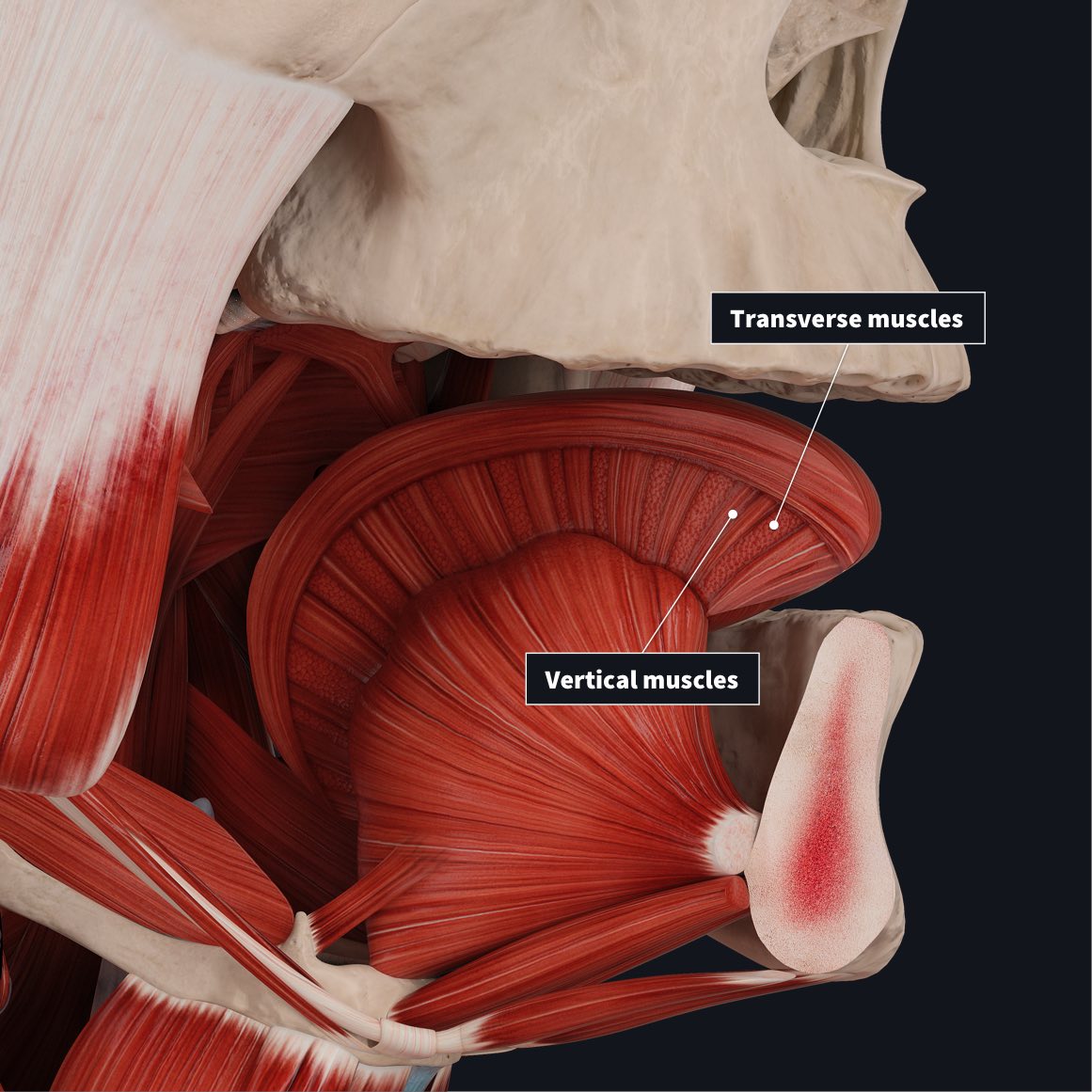
The tongue can degrease in size as the intrinsic muscles are toned (image from 3D4medical.com)
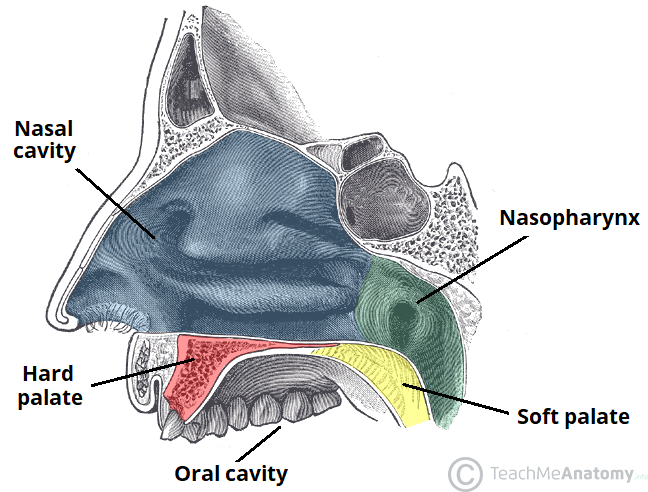
Hard palate is bone, soft palate is muscle. The soft palate can be toned for better breathing.
Problem #2: it feels like my tongue can't fit
This problem is very similar to the previous one. If you've spent a lifetime without having your tongue up, it may not fit properly when you first try Mewing.
Again, depending on the severity - you may need palatal expansion. However, in many cases, you will be able to use Mewing and myofunctional therapy to strengthen your tongue and achieve better and better tongue posture over time.
Your palate may be too narrow for your tongue right now, but, if you keep strengthening and toning it, as well as getting it used to being on your palate, it can become easier over time.
Problem #3: I can't get the back third up
Engaging the entire tongue on your palate is one of the most difficult aspects of Mewing. This is true for multiple reasons.
The first is that the posterior third of your tongue is the most difficult to control. I generally recommend people try using Myospots to do this since it's so difficult to consciously engage the posterior third.
Second, if you have forward head posture it will be even harder. That's why many people use the "chin-tuck" to engage their tongue more easily. In our program, we improve forward head posture through daily exercises so that the back third engages more fully.
Another aspect of your tongue posture is your tongue's mobility. Meaning, you may need to stretch the fascia and muscles underneath the tongue to allow it to engage on your palate.
Through deliberate exercises and stretches for your tongue, as well as improving your posture, you can get more and more of your tongue on your palate over time. However, many people will not be able to achieve PERFECT tongue positioning.
Again, it is not about perfection. It is about progress. The more of your tongue you can get up there, the better your results will be.
Fixed Restriction - Is your palate too narrow?
Although you can improve your tongue posture, for some it will be more difficult than others.
If your upper palate is very narrow, engaging the back third of your tongue may be very difficult. In these circumstances, palatal expansion from a dentist may be necessary.
Problem #4: my tongue is pressing unevenly left-to-right
I was in the office of a very experienced holistic dentist in Toronto, and I decided to ask him about my asymmetry. His response was: "everyone has some degree of asymmetry."
It made sense. Nobody is perfectly symmetrical (although some may be close). However, some people have more drastic asymmetry than others.
If you feel like one side of your tongue is pushing up more than the other, it's a good idea to try and correct this. Sometimes, if you keep trying to do Mewing despite asymmetry, it can become worse.
If one side of your tongue more readily engages on your palate than the other, simply trying to "push your tongue harder" may just cause that side to be even more dominant.
To get the best results possible with Mewing, we must get the entire tongue engaged on our palates as much as possible. This includes left-to-right.
How do you correct and improve this asymmetry? There are many ways. Here are a few you can try out:
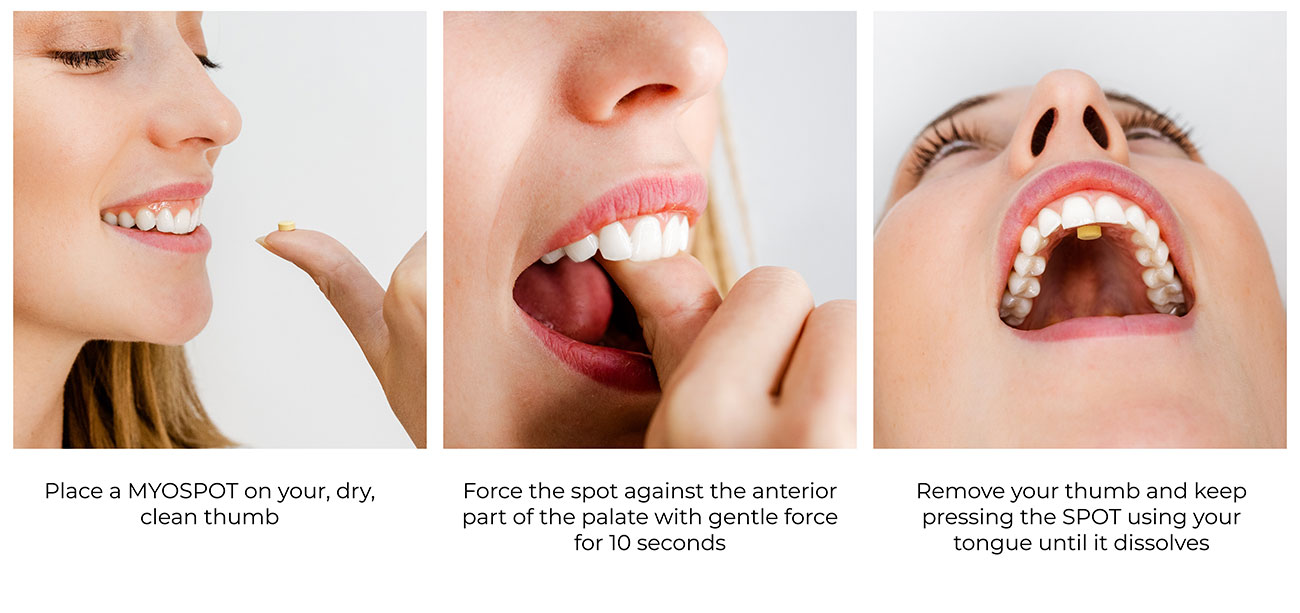
Myospots can be used to even out asymmetry in tongue position
1) Using Myospots: Myospots can be a great way to even out tongue pressure. Put a Myospot on the back third of your palate, about a centimetre closer to the weaker side. This will encourage that side of your tongue to engage. Over time, this will help balance out the strength of the tongue.
2) Improving asymmetry in your posture: when I first started the BFF Youtube channel, I made a video about asymmetry that since has gotten over 500,000 views. Many commented saying the stretches immediately fixed their asymmetry! If our forward head posture is worse on one side, it will make it harder for our tongue to engage that side.
Therefore when you stretch that tighter side of your neck, you improve the asymmetry in your forward head posture. Once you do this, you will IMMEDIATELY notice your tongue posture becoming more even.
However, it doesn't stop at your neck. Our entire body is connected. If you have an asymmetry in your head and neck region, it will follow into your thoracic and lumbar spine as well.
This is why we devote so much time to stretching uni-laterally in our program to even out these imbalances. However, any stretching & corrective exercise routine will help to improve this. Things such as Yoga, core strengthening routines, and using dumbells vs. barbells for weight training can help with imbalances.
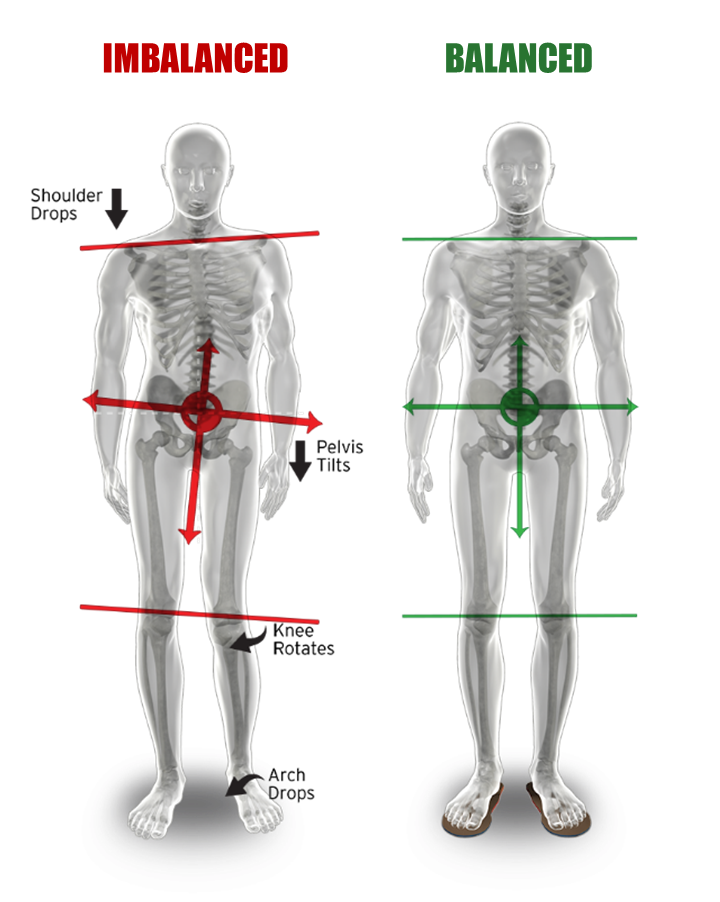
Imbalance in the neck will trickle down the rest of the body
Summing it up: the Mewing habit
Hopefully, this article has cleared up some of the confusion around Mewing and tongue posture. If you're new Mewing, this may have all been a bit much.
It seems like it shouldn't be this complicated, right? I agree...
In fact, for our ancestors - it wasn't. Most people had perfect teeth, tongue posture, and body posture without trying. It's only because of a lifetime's worth of bad habits that many of us need to put all this effort into correcting them.
So, what should you do? Where should you start?
Here are some ideas:
1) Do our introductory course on tongue posture and improving. It is completely free and dense with valuable information and techniques
2) Practice consciously Mewing on a regular basis
3) Do a daily exercise program to improve your posture. Some sample exercises are included in our introductory course
4) Visit a holistic dentist if you wish to have your specific scenario looked at more precisely
Finally, take a deep breath. All of this can be overwhelming. It takes a toll on many people's mental health (including mine at points in my life). Having been there myself, my advice is to control what you can to improve. Accept yourself now as best you can. Realize that nobody's perfect, and that the goal is not perfection,
The goal is progress.
Thanks for reading!
